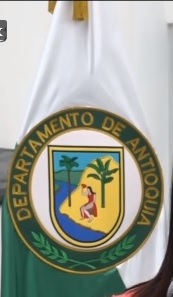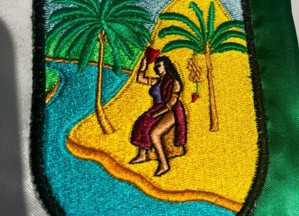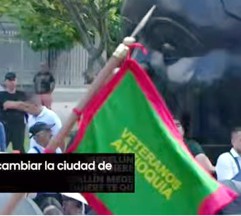 (1:2)
(1:2)Official Flag
image by Jaume Ollé'

Last modified: 2025-04-12 by daniel rentería
Keywords: antioquia | colombia | palm tree | plane tree | matron |
Links: FOTW homepage |
search |
disclaimer and copyright |
write us |
mirrors
 (1:2)
(1:2)
Official Flag
image by Jaume Ollé'
See also:
Communication from Esteban Rivera, based on the
information of the Tourist Guide "Antioquia: World of
Delights" -Turantioquia - 2th ed. 199, page 28:
"The flag has its origin in the University of Antioquia (Universidad de Antioquia - founded
in 1822), that nearly since its foundation had between its
emblems a green and white flag that was hoisted in all its
official acts. In 1962, by order of the departmental Assembly it
was decreed the use by the department of the same flag as that of
the University of Antioquia.
With respect to the department’s coat-of-arms the government
of the State of Antioquia determined by decree of 23 August 1812
to represent the coat-of-arms in the following form: a matron
dressed and adorned like an Indian, sat at the bottom of a golden
hill between the plane tree and the palm tree, with a copious
river at her feet, wearing in her head the cap of the French
revolution. The golden hill represents wealth and virtue; the
palm tree, triumph and victory; the plane tree, abundance; the
cap, freedom; the matron, the Antioquian race."
Jaume Ollé'
Antioquia adopted the flag by Ordenanza 6 of 10 December 1962
; CoA adopted on 23 August 1812 by Decerto number 21.
Felipe Carrillo, 15 July 2002
The official information can be found at www.antioquia.gov.co/escudo.htm
(official description of the Coat of Arms in Spanish) and www.antioquia.gov.cos/bandera.htm
(official description of the flag in Spanish).
E.R., 12 September 2005
 (2:3) image by Jaume Ollé
(2:3) image by Jaume Ollé
Flag of Regular Use
 image by Eugene Ipavec and Jaume Ollé, 12
September 2005
image by Eugene Ipavec and Jaume Ollé, 12
September 2005
Flag of Antioquia with Coat of Arms as seen at photo at www.metroseguridad.gov.co.
E.R., 12 September 2005
 image by Esteban Rivera,
8 November 2018
image by Esteban Rivera,
8 November 2018
I came across a variant flag featuring the flag charged with the coat of arms
with a different color scheme for the coat of arms where the hills are yellow, a native woman wears a red dress and holds in her right arm a
Phrygian cap. The flag also includes the words "DEPARTAMENTO DE ANTIOQUIA" in
golden letters surrounding the shield in a green ring, and below are two laurel
wreaths.
A (more or less) official description is found on the official
website (translated directly from Spanish):
"On August 23, 1812, the
Senate Chamber (as it was denominated to the corporation made up of the
deputies of the different cantons and provinces) (which is currently the
Asamblea Departamental, or Department Assembly), issued Decreto No. 21
according to the following terms: "(the) Senate Chamber, Antioquia, (dated)
August 23, 1812 ...
That the State takes for Arms in its public blazons and
in the Great Seal of the business bureau, a matron dressed and adorned in
Indian form, seated between a banana (tree) and a palm tree, reclining to the
foot of a hill of gold, with a mighty river at its feet, holding in the most
graceful attitude, the cap of freedom ... " which symbolizes the following:
the hill stands for wealth and virtue; the palm tree stands for the triumphs
and the victories; the banana tree stands for abundance; the (Phrygian) cap
stands for the freedom; and with the
matrona (a woman leader), the "Antioquian
race"."
Source:
http://www.antioquia.gov.co/index.php/antioquia/datos-de-antioquia
(which in turns quotes
https://es.wikipedia.org/wiki/Escudo_de_Antioquia).
Image cropped from a screenshot from TV
news Hora13 aired today.
Esteban Rivera, 8 November 2018
 image by Eugene Ipavec, 19 June 2006
image by Eugene Ipavec, 19 June 2006
I went to this gas station here in Medellin and saw several
vertical flags. Among them is the vertical flag of the Department
of Antioquia.
E.R., 19 June 2006

 images from Teleantioquia and
El Colombiano
images from Teleantioquia and
El Colombiano
Today during the investiture of current Governor of the Department of
Antioquia, one can see the newly appointed Governer wearing his
Governor sash (a diagonal stripe with two equal stripes from left to
right bottom green and top white, with the CoA superimposed in the
middle.
Esteban Rivera, 1 January 2024
 inauguration video of the MedellÃÂn mayor
inauguration video of the MedellÃÂn mayor
There's a pennant featuring a green background with red outline with
the inscription "VETERANOS" (English: Veterans) on top and "ANTIOQUIA"
below. However, no clear indication allows us to confirm whether it's
related to the military or the Police.
Esteban Rivera, 1 January 2024
Medellín and its Metropolitan Area - Medellín, the capital
of the Department of Antioquia, together with other
municipalities, form the "Área Metropolitana del Valle de
Aburrá, or Metropolitan Area of the Aburra Valley. This is for
economic purposes, in order to get more funds from the central government.
They have an English page available at www.metropol.gov.co
This "Area" is made up of 10 municipalities, which are
as follows:
Caldas
La Estrella
Sabaneta
Itaguí
Envigado
Medellin
Bello
Copacabana
Giradota
Barbosa
Each one has its own flag, anthem and Coat of Arms.
Esteban Rivera Velez, 5 September 2001
Área Metropolitana del Valle de Aburrá, AMVA, was established through
Ordenanza Departamental Nº34 de noviembre 27 de 1980,
based on the Decreto No. 3104 del 14 de Diciembre de 1979
for the promotion, planning and coordination of joint development and provision of services in the municipalities that comprise it.
Sources: https://www.metropol.gov.co/area/Paginas/somos/quienes-somos.aspx,
https://www.metropol.gov.co/area/Paginas/somos/Historia.aspx,
https://co.linkedin.com/company/areametropol
and https://www.metropolis.org/sites/default/files/resources/Global-state-metropolis-Valle-de-Aburra_AMVA_Oct2019.pdf
There is only the logo for the moment as corporate identity, which is a green background square with the name in white.
Esteban Rivera, 9 May 2024
.jpg) image located by Esteban Rivera, 9 May 2024
image located by Esteban Rivera, 9 May 2024
ant.jpg) image contributed by Felipe Carrillo, 7 July 2002
image contributed by Felipe Carrillo, 7 July 2002
ant1.jpg) image contributed by
Esteban Rivera, 09 August 2013
image contributed by
Esteban Rivera, 09 August 2013
The fist Seal (which eventually developed into the first Coat of Arms) of the
Department of Antioquia.
Source:
http://www.banrepcultural.org/sites/default/files/lablaa/revistas/credencial/marzo2010/imagenes/escudo2.jpg
taken from
this website. The respective GIF image is
here.
The inscription reads: "FE PVBLICA DEL ESTADO LIBRE E YNDEPENDIENTE DE
ANTYOQVA" (in old Spanish), in current Spanish would be "Fé Pública
Del Estado Lybre E Independiente De Antioquia", which translates as
"Public Faith of the Free and Independent Antioquia"), surrounded by a
palm (right) and and olive branch (left). Inside the Coat of Arms, in the first
quarter, there's a tree with a crow (being the Coat of Arms of
Santa Fé de
Antioquia, the second
quarter is a tower (being the Coat of Arms of Medellín, the third quarter is a lion
(being the Coat of Arms of Rionegro, and the fourth quarter being two holding hands (being the
Coat of Arms of Marinilla). Below, are the
initials R.Z.C.B.Y.C., that stand for Remedios,
Zaragoza, Cáceres, San Bartolomé,
Yolombó y Cancán (hoy Amalfi).
Independence was declared on August 11, 1813 and this Seal was approved
by the President of Antioquia, José María Montoya Duque, by Decree,
naming it the "Gran Sello de Antioquia" (Great Seal of Antioquia) on
September 2, 1813.
Sources:
http://www.lablaa.org/blaavirtual/historia/primera/antioquia.htm
and
http://es.wikipedia.org/wiki/Escudo_de_Antioquia#Sello_de_la_Rep.C3.BAblica_de_Antioquia
Esteban Rivera, 09 August 2013
 image created using logo from antioquia.gov.co
image created using logo from antioquia.gov.co
image: [1] by Esteban Rivera,
contributed 21 February 2025
The "Instituto para el Desarrollo de Antioquia" (IDEA) or Institute for the Development of Antioquia is a public promotion and development establishment, whose main objective is to
cooperate in the economic, cultural and social promotion of the department of Antioquia and its municipalities, through the provision of credit and guarantee services in favor of public service
works carried out in the country. It was established through "Departamental Ordinance Nº34 of November 27 1980" according to idea.gov.co Sources: [1], [2],
[3], [4], and [5].
The flag is a white horizontal background with the logo in the middle with the organization's name below in green lettering, the logo being a set of green leaves in the shape of Antioquia's map.
Esteban Rivera, 21 February 2025
.jpg)
-ins.jpg) first image from idea.gov.co and second from antioquia.gov.co
first image from idea.gov.co and second from antioquia.gov.co
2.jpg) image from antioquia.gov.co
image from antioquia.gov.co
It is the organization's initials in black capitals with an outter green rim, and the letter "D" featuring the silhouette of Antioquia's map.
Esteban Rivera, 21 February 2025
1.jpg) image from antioquia.gov.co
image from antioquia.gov.co
It is a railway beam profile in green with the organization's initials across in green as well, since the funds for the establishment of the organization came from the selling of "Ferrocarril de Antioquia" (English: Antioquia Railway) to the Nation's central government.
Esteban Rivera, 21 February 2025